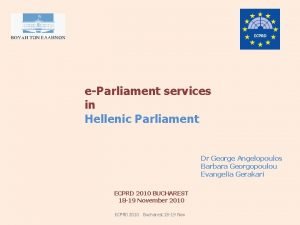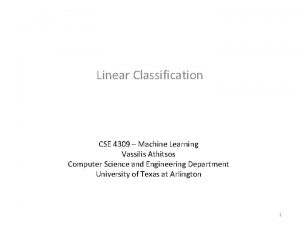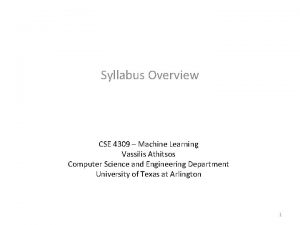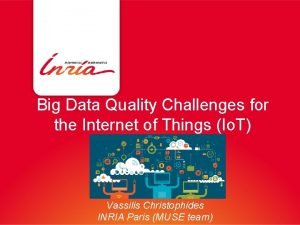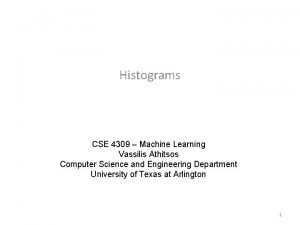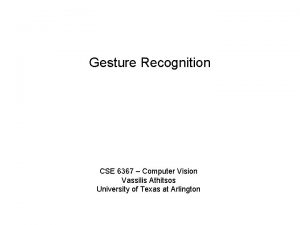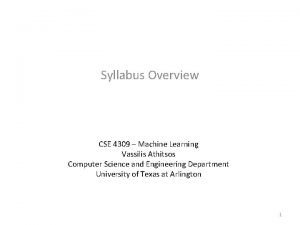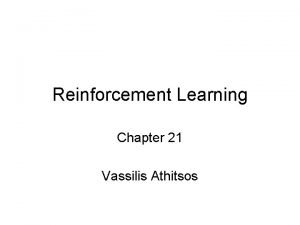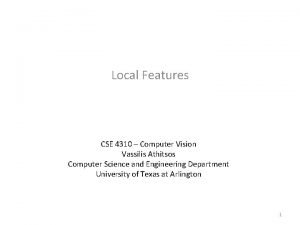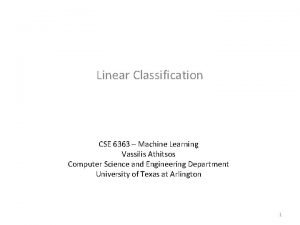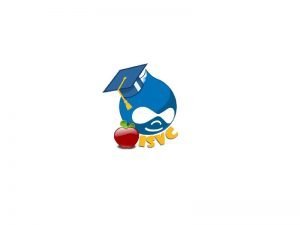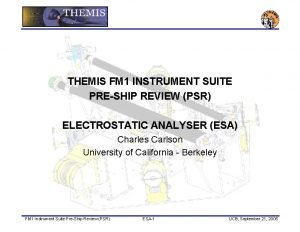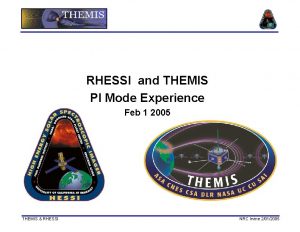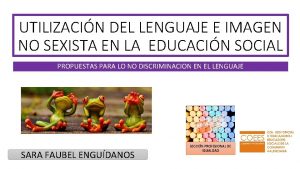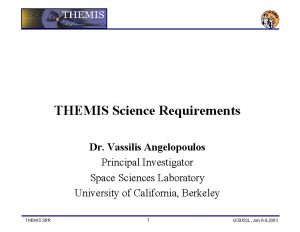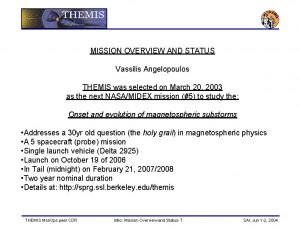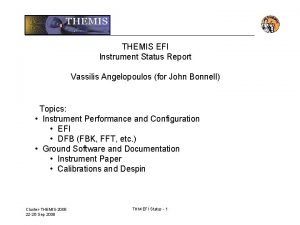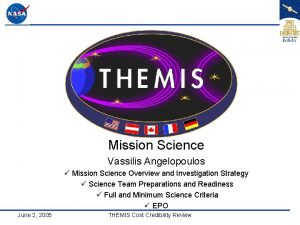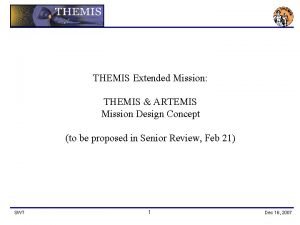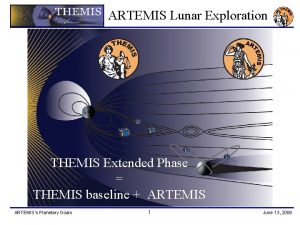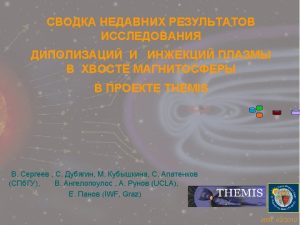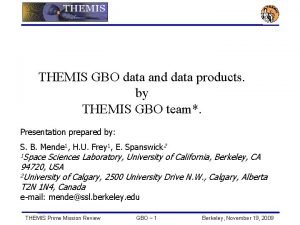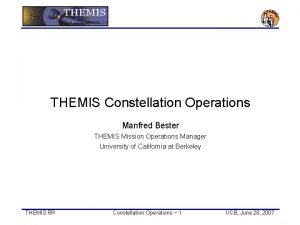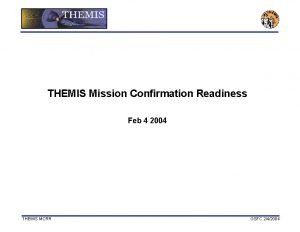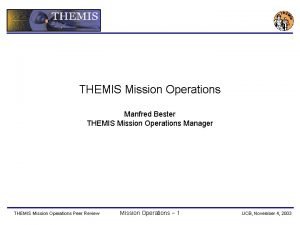THEMIS program an Overview Vassilis Angelopoulos THEMIS Principal













- Slides: 13

THEMIS program: an Overview Vassilis Angelopoulos THEMIS Principal Investigator THEMIS/GBO peer PDR 1 UCB, October 17, 2003

THEMIS was selected on March 20, 2003 as the next NASA/MIDEX mission (#5) to study the: Onset and evolution of magnetospheric substorms • Addresses a 30 yr old question (the holy grail) in magnetospheric physics • A 5 spacecraft (probe) mission • Single launch vehicle (Delta 2925) • Launch in August of 2006 • In Tail (midnight) on February 21, 2007/2008 • Two year nominal duration • Extended phase of 2 years possible (overlap with Cluster and MMS) • Details at: http: //sprg. ssl. berkeley. edu/themis THEMIS/GBO peer PDR 2 UCB, October 17, 2003

Auroral eruptions and substorms …are a manifestation of magnetospheric substorms SO W LA IN R D Auroral eruptions… MAG NETO Aurora EQU ATO THEMIS/GBO peer PDR 3 RIA SPHE L PL RE ANE UCB, October 17, 2003

Compelling science driver Substorms are: Fundamental processes… • …for understanding magnetospheric transport • … for basic physics …and important for space science • Sun-Earth-Connections Objective #1: “Understand the changing flow of energy and matter through … planetary magnetospheres” • US National Academy of Sciences: “A strategic question in space physics” SEC Objective#2: Explore fundamental physical processes of plasma systems • … for space weather and society THEMIS/GBO peer PDR • SEC Objective #3: “Define origins and societal impacts of variability in SEC” 4 UCB, October 17, 2003

Most important science result and its science impact Answers how substorms operate ASTROSPHERE – Explains how magnetospheres process solar wind energy GALACTIC CONFINEMENT SUBSTORM RECURRENCE: MERCURY: 10 min EARTH: 3. 75 hrs JUPITER: days – Explains how auroras erupt THEMIS/GBO peer PDR 5 UCB, October 17, 2003

Events occuring during a substorm Auroral Eruption THEMIS/GBO peer PDR 6 Current Disruption Reconnection UCB, October 17, 2003

Distinguishes among competing models: impartially answers a well-posed question… Primary Objectives, Goals and Means Onset and evolution of substorms Time History of Events (Onset)… – Delineate cause and effect • Measure When Where ? Current Disruption Model ? Reconnection Model time. Event time Event 0 sec. Current Disruption 0 sec Reconnection 30 sec. Auroral Eruption 90 sec Current Disruption 60 sec. Reconnection 120 sec Auroral Eruption Rarefaction wave ? Flows GBO … and Macroscale Interactions during Substorms (Evolution) P 3 P 5 P 4 P 2 P 1 – Coupling in the magnetosphere • Measure plasma flows and waves – Coupling to the ionosphere …as implied by Themis, goddess of impartial justice • Measure currents and structures THEMIS/GBO peer PDR 7 UCB, October 17, 2003

Mission elements Probe conjunctions along Sun-Earth line recur once per 4 days over North America. … while THEMIS’s space-based probes determine onset of Current Disruption and Reconnection each within <10 s. Ground based observatories completely cover North American sector; determine auroral breakup within 1 -3 s … : Ground Based Observatory THEMIS/GBO peer PDR 8 UCB, October 17, 2003

Extensive orbit study shows high event yield THEMIS’s goal is to study >10 substorms w/ 4 - or 5–probe alignments along X [limit case]. Met w/ >50% margin by a fault-tolerant orbit strategy. . • Need 188 hrs; have 300 hrs/yr (>50% margin) – computation includes lunar, solar, drag, J 2 terms – Conditions: d. YP 1, 2, 3, 4, 5<± 2 RE; d. ZP 2, 3, 4/NS<± 2 RE • Ascent: – minimizes shadows and post-L&EO ops – maximizes science (conjunction durations) • Mission immune to probe insertion errors – RCS capability of d. V<8 cm/s exceeds rqmt d. V<80 cm/s • … 3 rd stage insertion errors – long duration piece-wise major DVs with ground contact THEMIS/GBO peer PDR 9 UCB, October 17, 2003

Mission overview: Fault-tolerant design has constellation and instrument redundancy D 2925 -10 @ CCAS EF Ia EFIs SCM ESA BGS SST ion ulat aps Enc unch & la Operations UCB FGM Mission I&T Swales Tspin=3 s Instrument I&T UCB Ground THEMIS/GBO peer PDR 10 Probe instruments: ESA: Thermal plasma (UCB) SST: Super-thermal plasma (UCB) FGM: Low frequency magnetic field (TUBS/IWF) SCM: High frequency magnetic field (CETP) EFI: Electric field (UCB, LASP) UCB, October 17, 2003

Synergy with Cluster and MMS – Ideal overlap of objectives and orbits With MMS (2008) THEMIS/GBO peer PDR With Cluster/Double. Star (2006) 11 UCB, October 17, 2003

Inspires young minds and excites public “Student-operated instruments detect space storms affecting satellites and humans in space” – EPO ground magnetometers at K-12 schools: • Promote inquiry-based and theme-based instruction • Allow hands-on student participation SFUSD Teachers ‘ 01 Captures public imagination: – Auroral eruption trigger identified in space – Substorms, key to predicting space weather RHESSI Solar Camp ‘ 00 Expands on existing partnerships and resources: – Space Grant Consortium – Science museums – International collaborations Total eclipse ’ 98, SF Exploratorium THEMIS/GBO peer PDR 12 UCB, October 17, 2003

Summary Fully answers a compelling science question Ushers a new era in magnetospheric physics Benefits international space science program Unique Timely: Science and technology pathfinder THEMIS/GBO peer PDR 13 UCB, October 17, 2003
